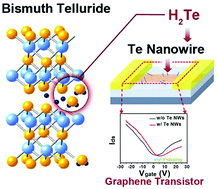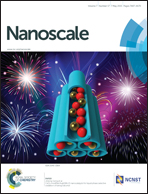Electrochemical synthesis of ultrafast and gram-scale surfactant-free tellurium nanowires by gas–solid transformation and their applications as supercapacitor electrodes for p-doping of graphene transistors†
Abstract
We herein report a gas–solid transformation mechanism for the surfactant-free synthesis of Te NWs at room temperature by electrolysis of bulk Bi2Te3 using H2Te gas. Te NWs, with an average diameter below 20 nm, grow along the [001] direction due to the unique spiral chains in the crystal structure and show an enhanced Raman scattering effect, a broad absorption band over the range of 350–750 nm and an emission band over the range of 400–700 nm in the photoluminescence spectrum. In terms of device applications, we demonstrate how Te NWs can be directly applied as a p-type dopant source in order to shift the Dirac point in ambipolar field effect graphene transistors. Finally, the favorable capacitive properties of Te NWs are established as supercapacitor electrodes with negligible internal resistance and excellent electrochemical reversibility and a specific capacitance of 24 F g−1.



 Please wait while we load your content...
Please wait while we load your content...